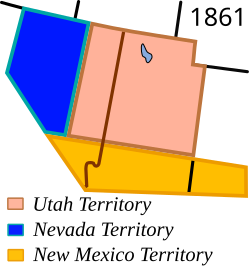Territory of Nevada
| Territory of Nevada | |||||
| Organized incorporated territory of the United States | |||||
|
|||||
| The Nevada Territory in 1861, with the Utah and New Mexico territories. | |||||
| Capital |
Genoa (1861) Carson City (1861–1864) |
||||
| Government | Organized incorporated territory | ||||
| Governor | James W. Nye | ||||
| History | |||||
| • | Organic act | March 2, 1861 | |||
| • | Statehood | October 31, 1864 | |||
The Territory of Nevada was an organized incorporated territory of the United States that existed from March 2, 1861, until October 31, 1864, when it was admitted to the Union as the State of Nevada.
Prior to the creation of the Nevada Territory, the area was part of western Utah Territory and was known as Washoe, after the native Washoe people. The separation of the territory from Utah was important to the federal government because of its political leanings, while the population itself was keen to be separated because of animosity (and sometimes violence) between non-Mormons in Nevada and Mormons from the rest of the Utah Territory.
A common misconception was that the Union needed Nevada's silver for the war effort, but as a U.S. Territory, the U.S. could take it if they so needed. Another misconception that Nevada was rushed into statehood was due to the 1864 Election, in which Abraham Lincoln needed a few more sure votes in the Electoral College to be re-elected. With Fremont dropping out of the race, Lincoln's margin of victory over McClellan was 212 to 21 so Nevada's two electoral votes weren't of consideration.
It was once said that Nevada was not quite populous enough to warrant statehood. However, the Northwest Ordinance of 1787 allowed a state to be admitted, "“Provided, the constitution and government so to be formed, shall be republican, and in conformity to the principles contained in these articles; and, so far as it can be consistent with the general interest of the confederacy, such admission shall be allowed at an earlier period, and when there may be a less number of free inhabitants in the State than sixty thousand.”
The eastern boundary of Nevada Territory had been defined as the 116th meridian, but when gold discoveries were made to the east the Nevada territorial delegation to Congress requested the boundary moved to the 115th meridian, which Congress granted in 1862. The border was shifted further east, to the 114th meridian, in 1866, in part due to the discovery of more gold deposits. These eastward shifts took land away from Utah Territory. The southern border of Nevada Territory had been defined as the 37th parallel, but in 1866 Nevada asked Congress to move the border south to the Colorado River. Congress granted the request in 1867, giving Nevada all of the western end of Arizona Territory. Arizona strongly protested, but found little sympathy in Congress due in part to Arizona having aligned with the Confederacy during the Civil War.
...
Wikipedia

